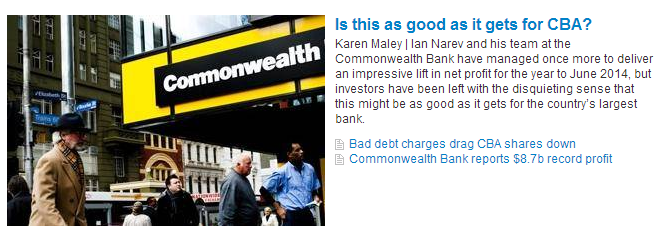
From the AFR:
In the biggest full-year profit for an Australian bank, Commonwealth Bank has delivered a cash profit of $8.68 billion, up 12 per cent, as it grew market share in home and business lending and bad debts remained at very low levels. The result came in a touch above analyst consensus estimates for a $8.64 billion full-year profit.
CBA will pay a $2.18 final dividend to take total dividends for the year to $4.01, up 10 per cent at a full year payout ratio of 75.1 per cent.
Chief executive Ian Narev said the bank was “cautiously positive” about the outlook for financial 2015.
“Whilst business and consumer confidence levels have remained fragile, the levels of underlying activity confirm the strong foundations of the Australian economy,” he said in a statement accompanying the results.
And more detail from Watermark via the SMH blog:
- Capital was the key stand out from the result, with CBA increasing its CET1 ratio by 110bps in FY14. This implies very solid organic capital generation even after accounting for the 28bp contributions from the property transactions.
- The 2H14 DPS was 2% lower than consensus expectations. CBA has announced that they intend to neutralise the DRP, which is in contrast to what they did at the first half result in February. WBC is also neutralising its DRP currently while ANZ and NAB are not.
- ROE has come in a little bit lighter at 18.3% vs. consensus expectations of 19.0%
- NIM outcome was pleasing given the building competitive pressures in lending, with NIM 1bp higher in FY14 and flat in 2H14. FY14 NIM was 1bp higher than consensus and 2H14 NIM was 3bp higher than expected.
- Bad debt charges have modestly increased in the half to 17bps in 2H14 from 16bps in 1H14. This seems to suggest we might have passed the sweet spot in the asset quality cycle and that bad debt charges could start to tick up marginally from here for the industry.
I expect things will begin to get more difficult from next year as the mining cliff and slowing house prices push up bad loans. We are already seeing it at the margin, from Banking Day:
Standard & Poor’s released its residential mortgage-backed securities arrears data for the month of June yesterday…
Looking at the change in sub-prime arrears since the end of March, arrears greater than 30 days have fallen as a percentage of the face value of subprime RMBS outstanding to 4.6 per cent from 5.4 per cent.
However, this disguises an 8.6 per cent increase in the dollar value of arrears to A$140.4 million, as the face value of sub-prime RMBS has increased by more than $650 million to almost $3.1 billion.
Of more concern is a 13.5 per cent increase in the dollar value of arrears greater than 60 days and a 12.7 increase in arrears greater than 90 days. These increases are hardcore and not just a temporary slip in making mortgage repayments.
More sub-prime borrowers are getting into difficulty and are in danger of losing their homes.
The same applies to some prime borrowers. In the case of prime RMBS, arrears since the end of March appear to have remained steady at 1.2 per cent of total RMBS, including internal securitisations. But analysis of the underlying numbers shows that arrears greater than 30 days have increased by four per cent to $1.4 billion.
Again, it is the greater than 60 days and 90 days buckets that have increased the most, at 4.8 per cent and 8.2 per cent respectively.
There is also the big regulatory risk brewing in the Murray Inquiry which appears determined to rein in the big four (if not the system). My guess is this is as good as it gets for profit growth and payout ratios.
Updated:
It seems MB has a fan in Karen Maley:


